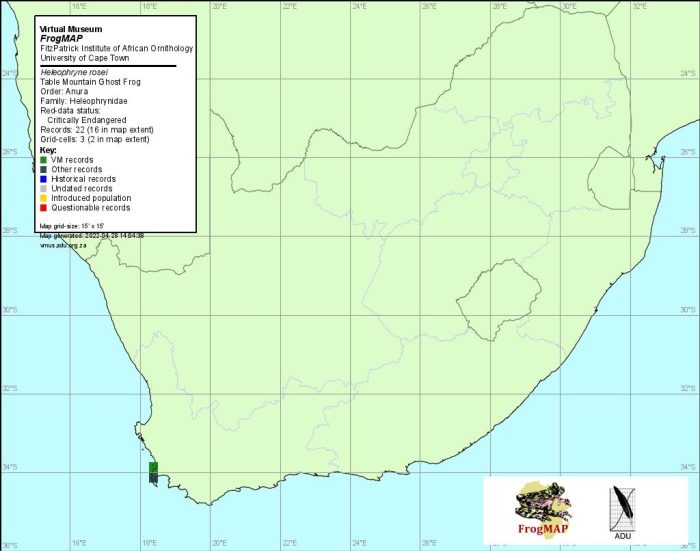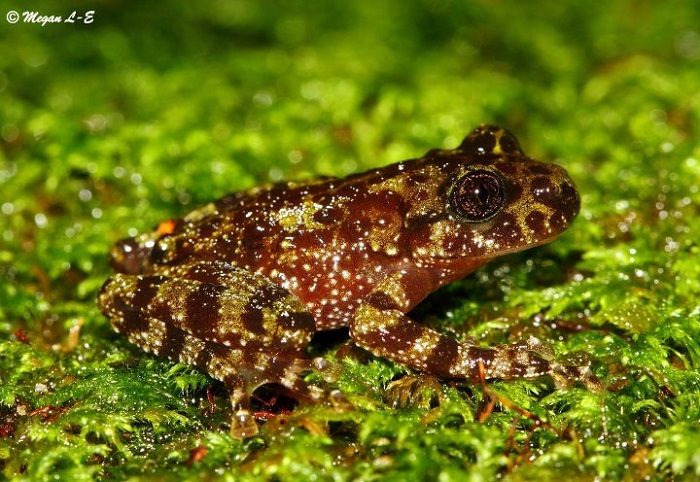Cover photo Megan Loftie Eaton.
Table Mountain Ghost Frog in the FBIS database (Freshwater Biodiversity Information System) here.
Family Heleophrynidae
Identification
Table Mountain Ghost Frog males reach 50mm and females attain 63mm in snout-vent length. They resemble other Heleophryne speciesin their body shape and posture, long limbs, and large spatulate, adhesive pads at the tips of their fingers and toes.
The dorsum is green with reddish-brown to purple mottling, while the ventrum is granular and generally white with pink shading.
Habitat
The Table Mountain Ghost Frog inhabits clear perennial streams situated in moist, forested ravines, gorges and valleys, or in fynbos on the more exposed slopes and shallow valleys, especially in the upper catchment areas. The vegetation types in these habitats are Afromontane Forest and Mountain Fynbos, respectively. The streams are rocky and fast-flowing for most of the year, forming waterfalls interspersed with slower-flowing sections and pools. (Boycott and De Villiers 1986).
Following metamorphosis, froglets move out of the streams to damp boulders, moss-covered rock faces and crevices close to the streams. Non-breeding adults have been found in damp, sheltered habitat well away from the streams, including caves (Gow 1963; Boycott and De Villiers 1986).
Behaviour
The Table Mountain Ghost Frog is cryptic and elusive and occurs in relatively low numbers. Its typical habitat is often inaccessible and consequently, there is limited information on breeding activity and general life history.
Breeding takes place in spring and summer, once the winter rains have ended and there is a reduction in stream flow (Boycott and De Villiers 1986). Skin asperities, a secondary sexual character, have been noticed in late August and are well developed by November and December. Gravid female frogs have been collected October–December, and a call was recorded in December 1978 (see sonagram in Passmore and Carruthers 1995). The eggs and oviposition site have not been recorded.
The distinctive tadpoles attain a length of 40–50 mm and are adapted to torrents. They have large, sucker-like oral discs which enable them to cling to rocky substrates in fast-flowing streams and to climb slippery, vertical rock faces. The tadpoles feed on algae covering the rock surfaces, and their feeding trails can be seen on rocks in quieter pools. During the day they are usually found attached to the underside of submerged rocks. H. rosei tadpoles take >12 months to complete metamorphosis, and are ready to leave the water by April or May.

Skeleton Gorge, Western Cape
Photo by Pieter la Grange
Status and Conservation
Status
The Table Mountain Ghost Frog was previously listed as Rare (McLachlan 1978) and Endangered (Branch 1988). The species is now classified as Critically Endangered, owing to its small extent of occurrence and area of occupancy (regarded as a single location) and a projected decline in the area of occupancy, habitat quality and number of mature individuals (Harrison et al. 2001; this publication). The species is legally protected by Nature Conservation Ordinance 19 of 1974. At present H. rosei is not listed by CITES.
Although H. rosei has suffered some habitat loss, this does not appear to have led to habitat fragmentation. However, the construction of two large reservoirs in Disa Stream and three in Original Disa Stream, between 1890 and 1907, must have obliterated a significant proportion of prime H. rosei habitat. The disappearance of the tadpoles of this species from Platteklip Gorge by 1980 may be attributed to climatic change, erosion and the spread of alien vegetation, while water abstraction and stands of alien trees are probably the main cause of its absence from Cecilia Ravine since 1997. It is estimated that the number of tadpoles in Skeleton Gorge has decreased by 50% since 1980. In total, 20% of the habitat of this species is estimated to have been lost since 1980.
Since 1997, systematic tadpole counts have been carried out in all streams at the end of summer when stream levels are at their lowest. At each monitoring site, tadpoles are counted over a 30-min period during the day. Between 1997 and 2001, <20 tadpoles were counted at each site, and on a number of occasions, <10 were seen (unpubl. data). This indicates that the species survives at low population densities and suggests that there has been a population decline since the earlier surveys were conducted.
Fortunately, all habitat of H. rosei is now protected within the recently proclaimed Cape Peninsula National Park and the undeveloped upper reaches of Kirstenbosch National Botanical Garden. In addition, the extensive clearing of pine trees and other alien vegetation on Table Mountain since 1980 has helped to improve the quality of H. rosei habitat in places.
Threats
Although H. rosei occurs within a protected area, its survival is not assured. For example, in other parts of the world, amphibian species have disappeared from protected mountainous regions as a result of the introduction of predatory fish, disease or environmental deterioration (Beebee 1997; Berger et al. 1998; Longcore et al. 1999). The fact that Table Mountain is situated next to a large city and is extensively utilized by human visitors (including foreign tourists), increases the possibility of introduction of disease.
Since metamorphosis in H. rosei takes >12 months, an uninterrupted flow of water is essential to the survival of the tadpoles. Consequently, global warming poses a serious threat if reduced rainfall and prolonged droughts lead to a loss of perennial streams. At present, most of the streams are reduced to a trickle by the end of summer, and few tadpoles are present. Similarly, large reservoirs in Disa Stream and Original Disa Stream represent a further potential threat to the water resources for tadpole populations. Elsewhere, water abstraction takes place in Cecilia Ravine and in the lower reaches of Window Gorge. It is essential to maintain the seasonal flow below dams throughout the year if tadpole populations are to survive in these parts of the streams (Boycott and De Villiers 1986; Boycott 1988c; Harrison et al. 2001). Invasive alien vegetation and plantations of exotic trees have also reduced runoff and stream flow. Furthermore, the presence of alien deciduous trees alongside streams (e.g. poplars) leads to the severe clogging of tadpole habitat with leaf-litter (Boycott and De Villiers 1986).
The effect of erosion on H. rosei habitat is difficult to determine, but increased siltation is believed to have caused the deterioration or loss of tadpole habitat in places. The erosion problem on Table Mountain is caused by alien vegetation and the removal of dense stands of introduced species, trampling by human pedestrian traffic, overgrazing and trampling by the invasive Himalayan Tahr, and too frequent fires (Moll and Campbell 1976).
Recommended conservation actions
The distribution and relative abundance of H. rosei is monitored by the Western Cape Nature Conservation Board as part of a threatened species monitoring programme (De Villiers 1997a), while the Cape Peninsula National Park and Kirstenbosch National Botanical Garden are responsible for the protection and management of the habitat of the species. In managing the habitat, priority is given to erosion control, eradication of alien vegetation and the regulation and maintenance of streamflow from the various reservoirs.
The monitoring of tadpole populations should be intensified to obtain a more accurate estimate of population size and its fluctuation from year to year. This will produce new information on the reproductive biology and phenology of the species.
There is potential for decline at the hands of unscrupulous collectors. Additional protection against illegal trade could be afforded by listing H. rosei in one of the CITES appendices.
Boycott and De Villiers (1986) suggested that the translocation of tadpoles to other streams on the mountain be considered. However, this is not recommended at present in view of the low numbers of tadpoles in known localities and the absence of suitable perennial streams in which the survival of the tadpoles could be guaranteed. A captive breeding programme for H. rosei is not recommended. The stocking of reservoirs and streams with predatory alien fish should be strictly prohibited for obvious reasons.
Distribution
The Table Mountain Ghost Frog occurs in the winter-rainfall region of the Western Cape and is endemic to Table Mountain on the Cape Peninsula (3318CD). It occupies an area of <10 km2 at an altitude of 240–1060 m. With the exception of a section of stream on top of the mountain which drains the western slopes, and one that drains the northern slope (historical record), H. rosei occurs mostly in streams draining the wetter southern and eastern slopes that receive annual rainfall of 1600–2000 mm.

During the 50-year period following its description, this rare and elusive frog was recorded from only a few scattered localities: Skeleton Gorge above Newlands, Wynberg Caves, Platteklip Gorge, the top of Window Gorge, upper Disa Stream, and Echo Valley near Grotto Caves (Hewitt 1925; Du Toit 1934; Gow 1963; Poynton 1964; records of the Western Cape Nature Conservation Board).
In 1980, a systematic survey recorded tadpoles in six streams (Boycott and De Villiers 1986). On the south-facing slopes they were found in Disa Stream (upper catchment section and below the reservoirs) and Original Disa Stream. On the east-facing slopes they were recorded from Window Gorge, Skeleton Gorge, Nursery Ravine and Cecilia Ravine. There were no signs of H. rosei on the northern and western slopes, including Platteklip Gorge, a previously recorded locality. During this survey, one adult and a few froglets were found in addition to tadpoles.
The most recent survey formed part of a threatened amphibian monitoring programme (De Villiers 1997a) and took place during 1997–1999. Tadpoles were found at all localities recorded during the 1980 survey except Cecilia Ravine. A new locality was discovered on top of the mountain in the upper section of a stream which drains into Kasteelspoort, in the Valley of the Red Gods. This represents the only confirmed record of the species in a stream that drains the west-facing slopes (unpubl. data).
In summary, H. rosei tadpoles have been recorded in a total of eight streams but the species is currently known to breed in only six. The atlas distribution data are reliable.
Further Resources
The use of photographs by Megan Loftie Eaton and Pieter la Grange is acknowledged.
Table Mountain Ghost Frog Heleophryne rosei Hewitt, 1925
Other Common Names: Tafelberg-spookpadda (Afrikaans).
Recommended citation format: de Villiers, AL; Tippett, RM. (2025). Table Mountain Ghost Frog Heleophryne rosei. Biodiversity and Development Institute, Cape Town. Available online at https://thebdi.org/2022/01/21/table-mountain-ghost-frog-heleophryne-rosei/
This species text has been updated and expanded from the text in the
2004 frog atlas: de Villiers, AL. (2004). Table Mountain Ghost Frog Heleophryne rosei. In Minter LR
et al 2004.
References:
Minter, LR; Burger, M; Harrison, JA; Braack, HH; Bishop, PJ; Kloepfer, D. (Editors). (2004). Atlas and Red Data Book of the Frogs of South Africa, Lesotho and Swaziland. Smithsonian Institution, Washington, and Avian Demography
Unit, Cape Town.
Carruthers, V; du Preez, L. (2017). Frogs of southern Africa: A Complete Guide. Struik Nature, Cape Town.
Channing, A. (2001) Amphibians of Central and Southern Africa. Protea Book House, Pretoria
Claus, B; Claus, R. (2002). Common Amphibians and Reptiles of Botswana. Gamsberg Macmillan, Windhoek.

